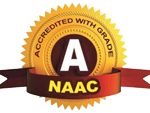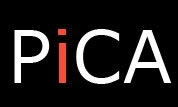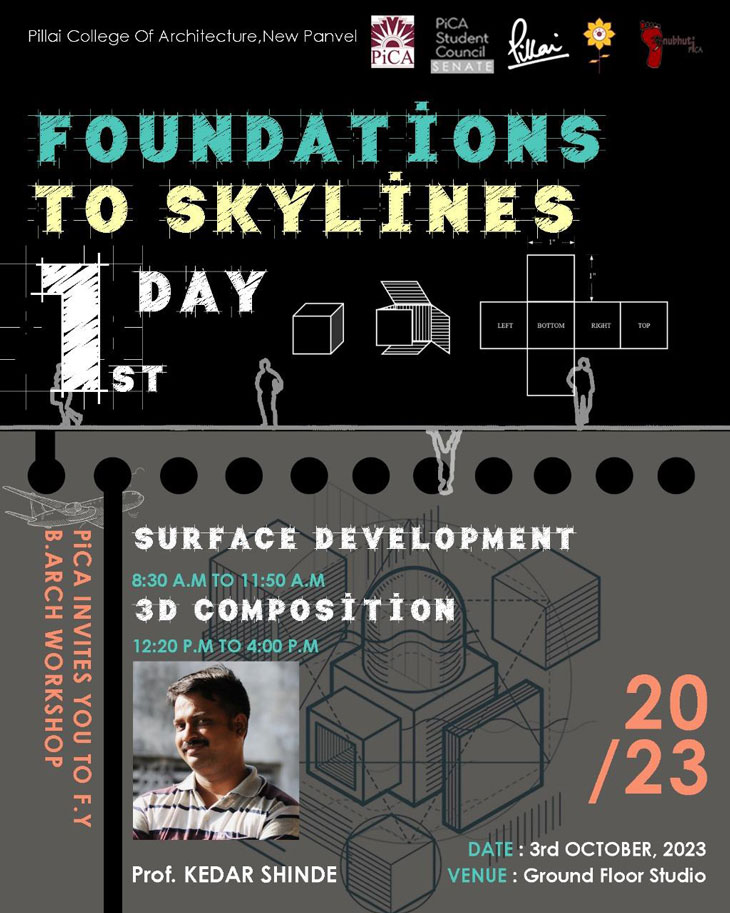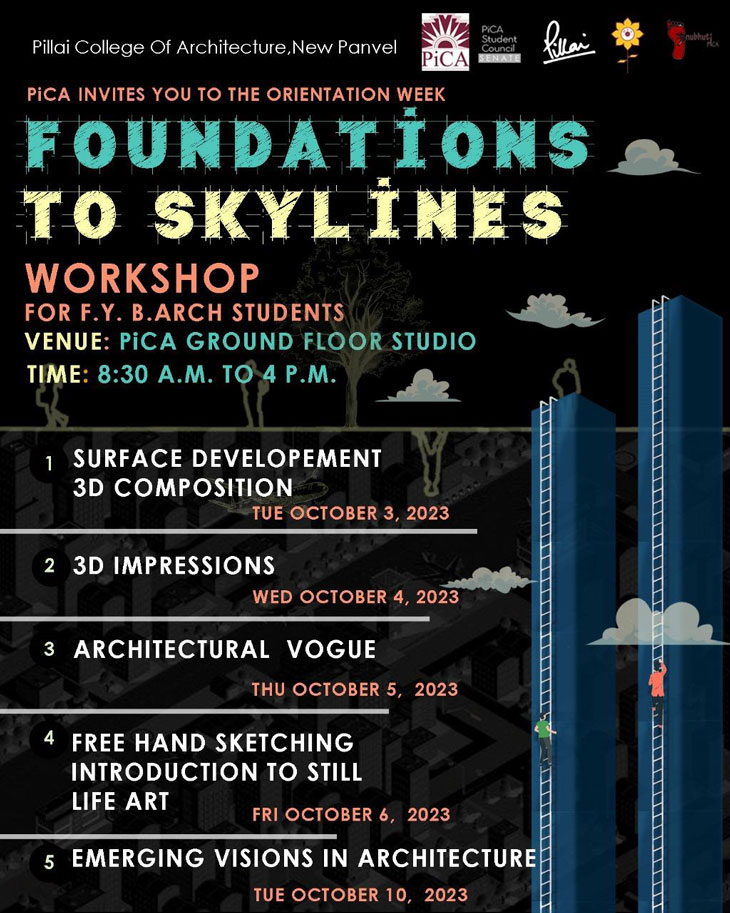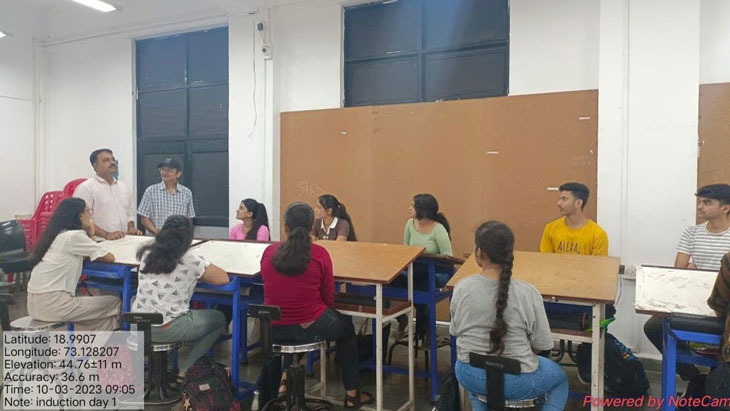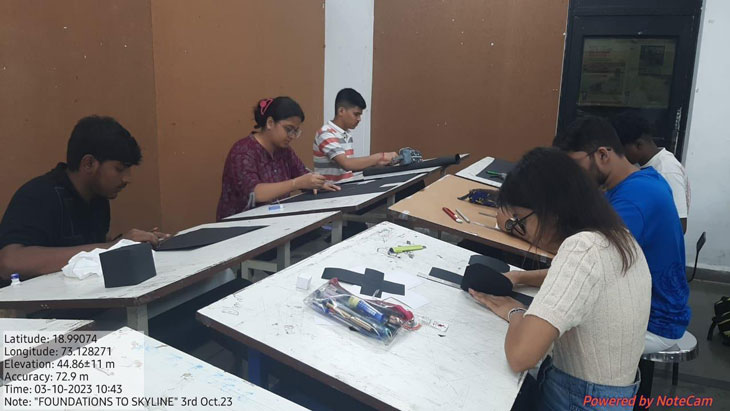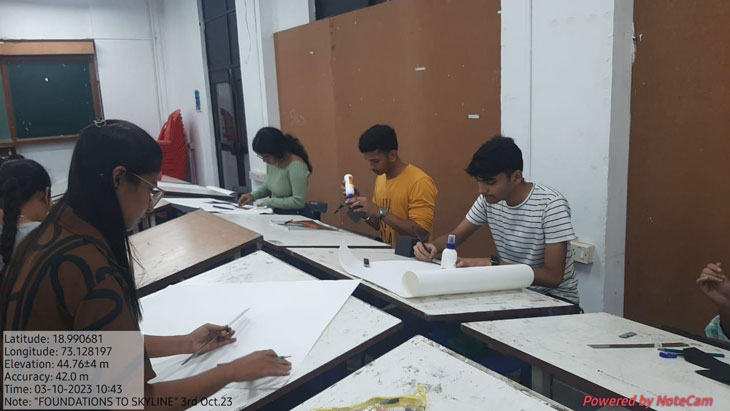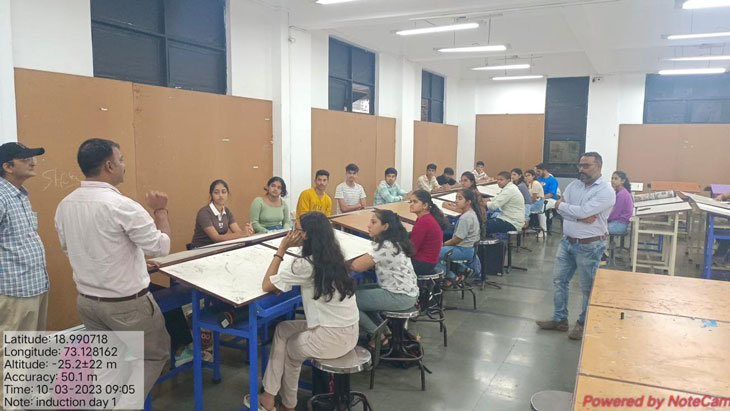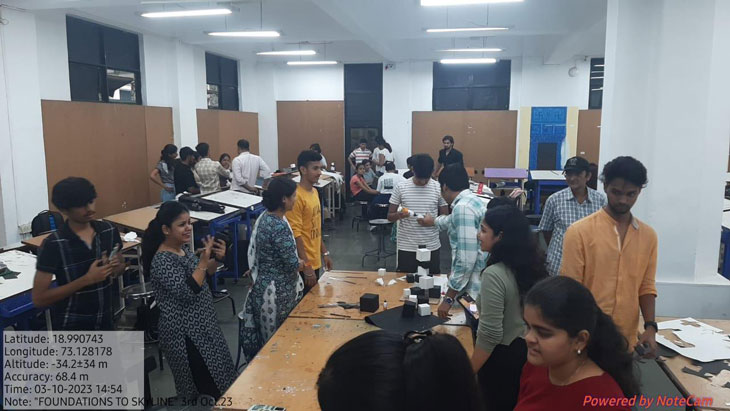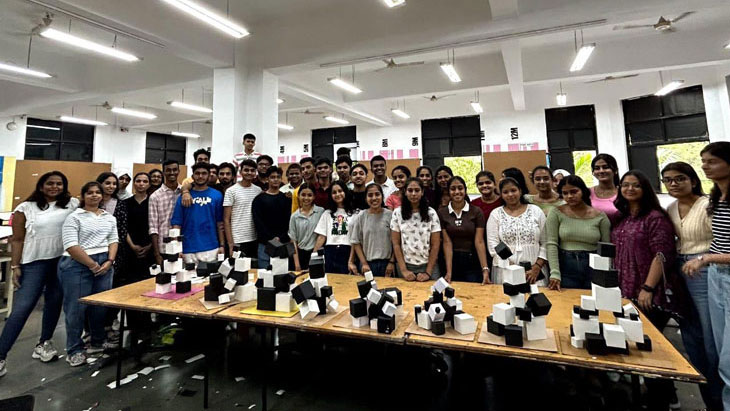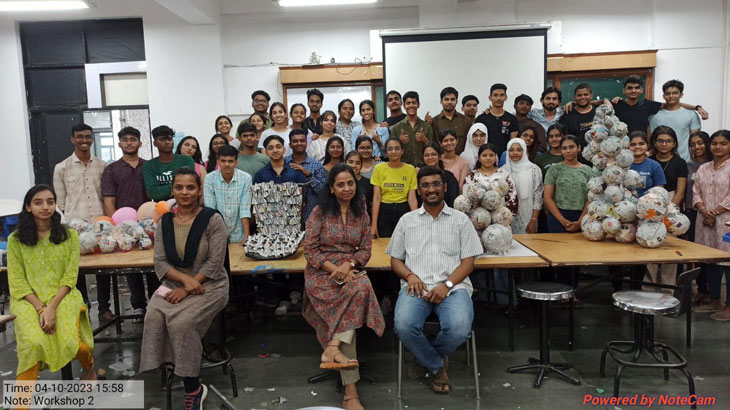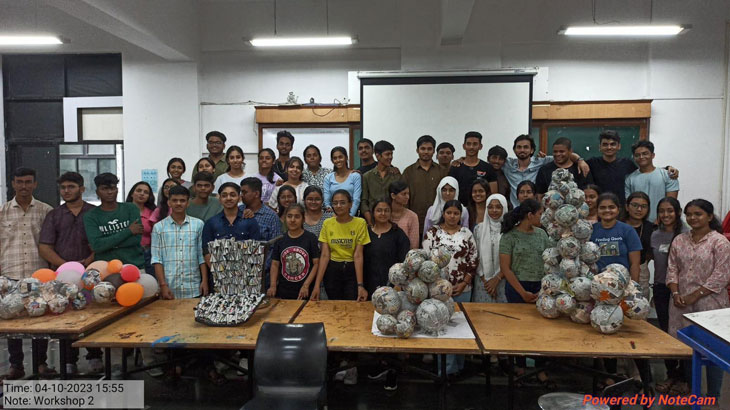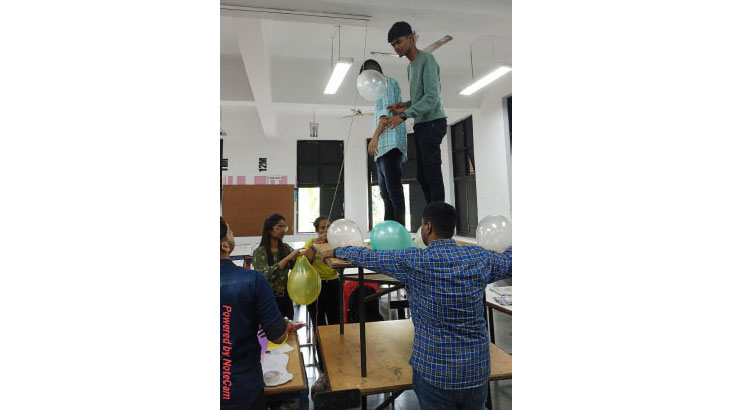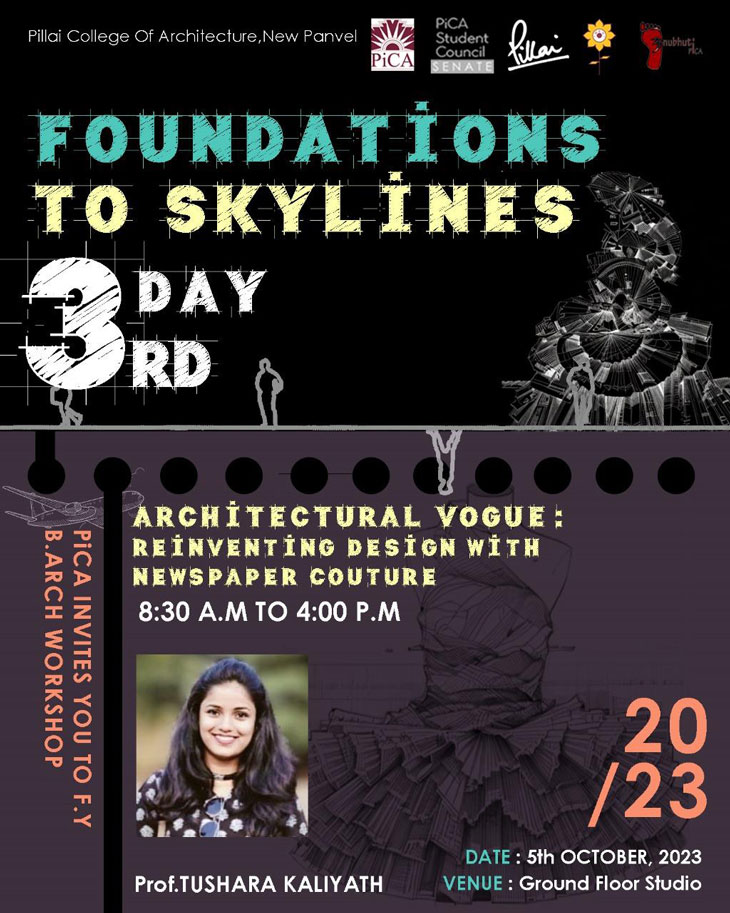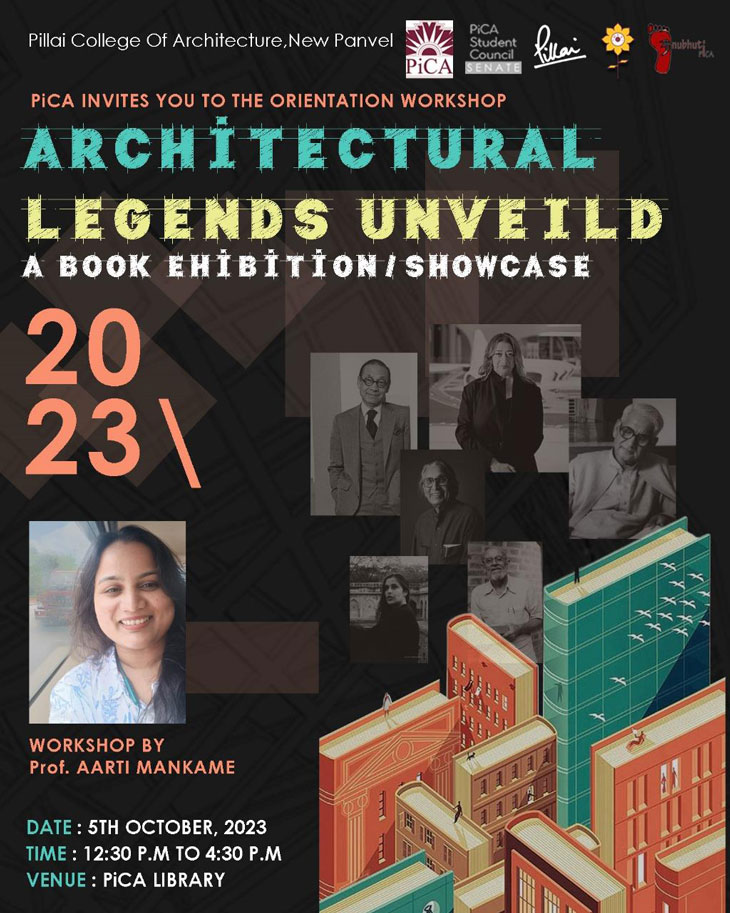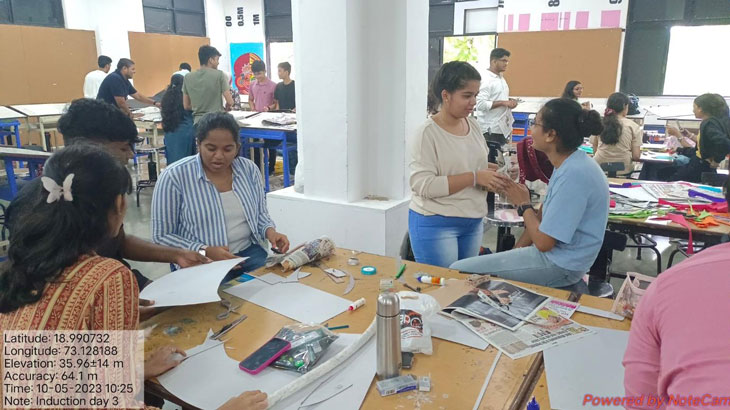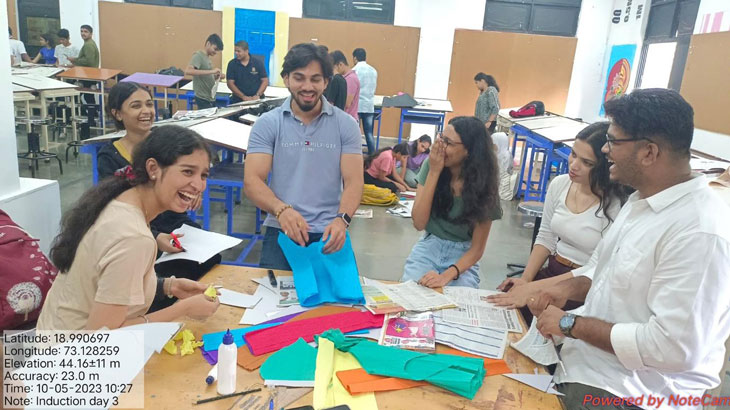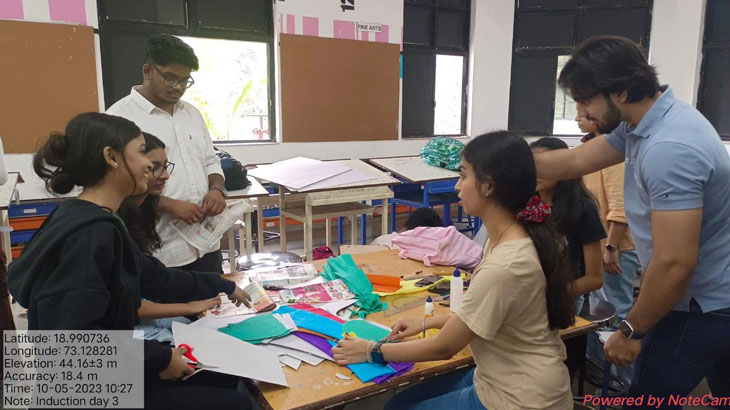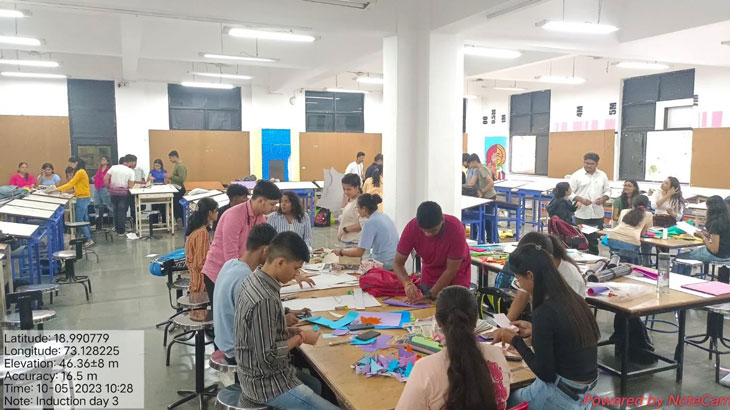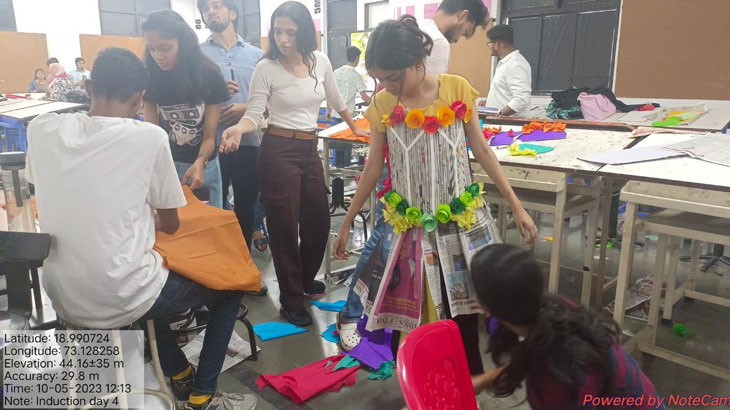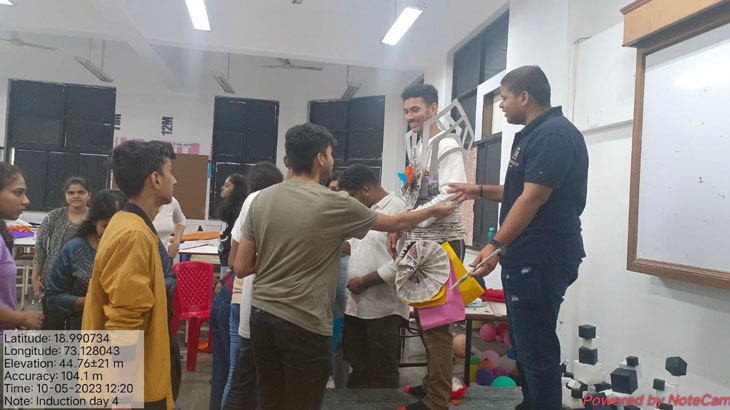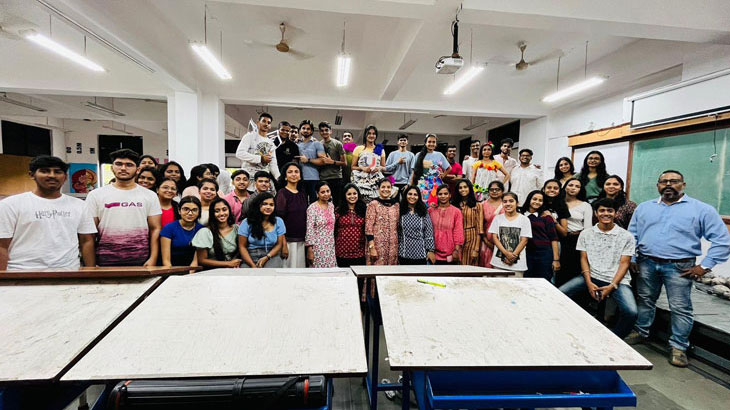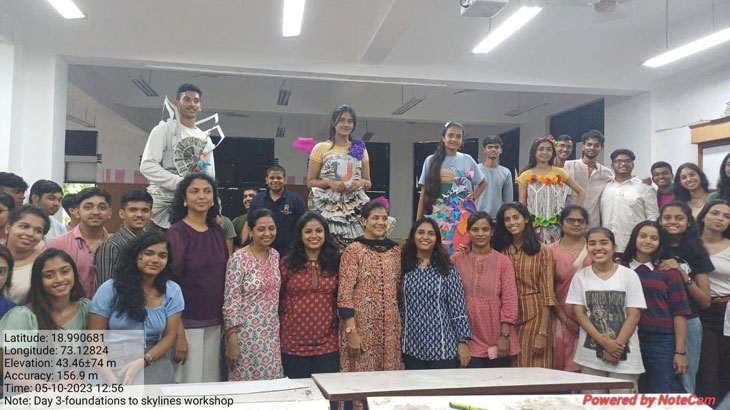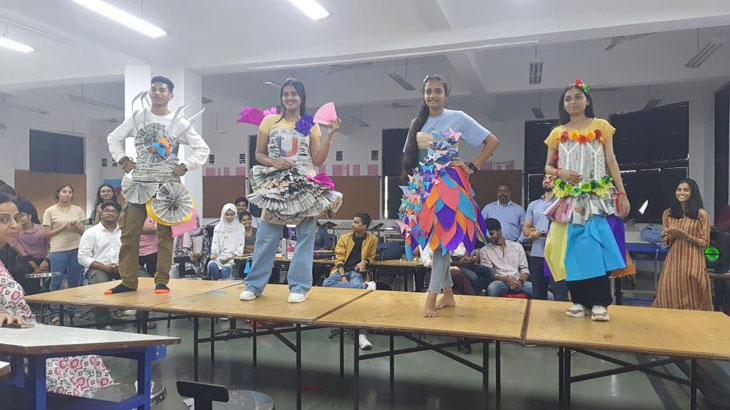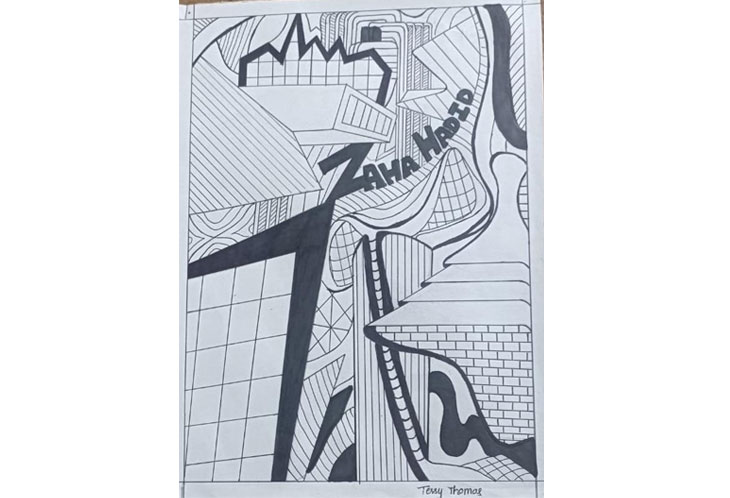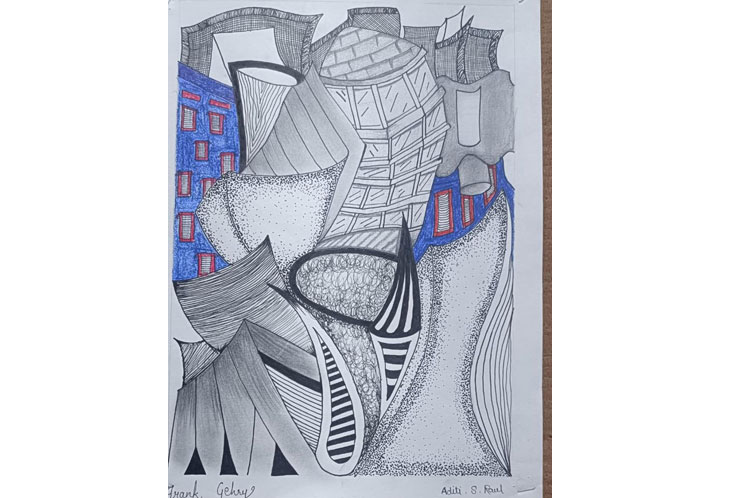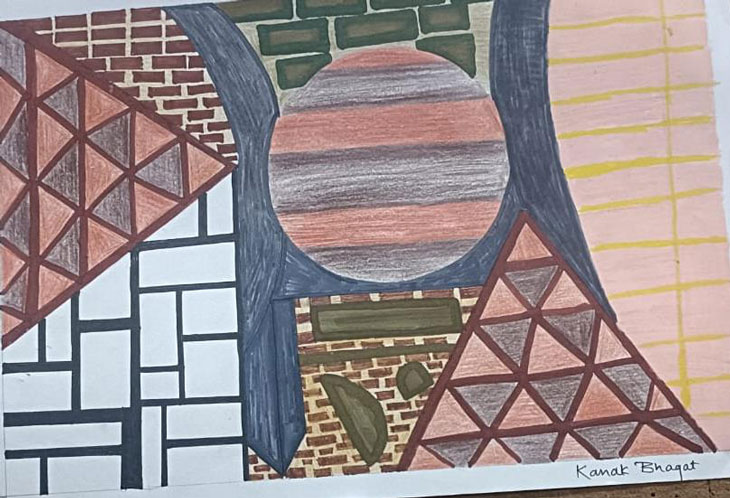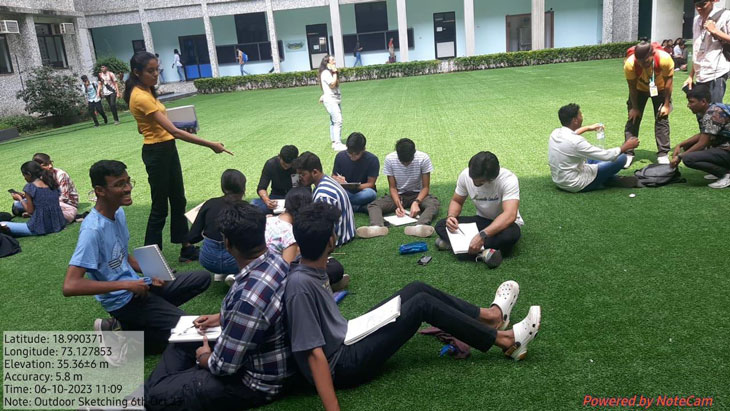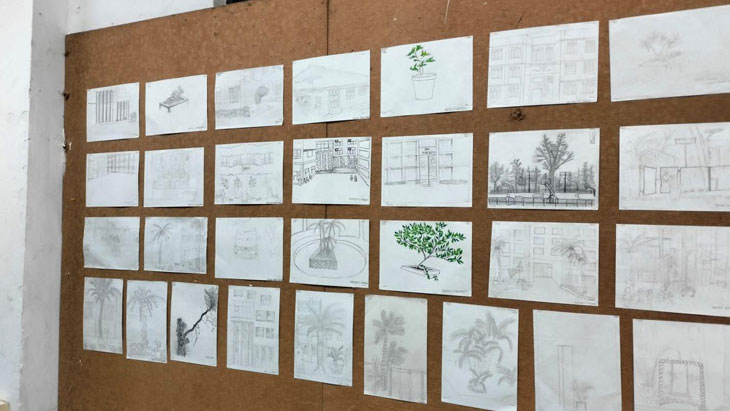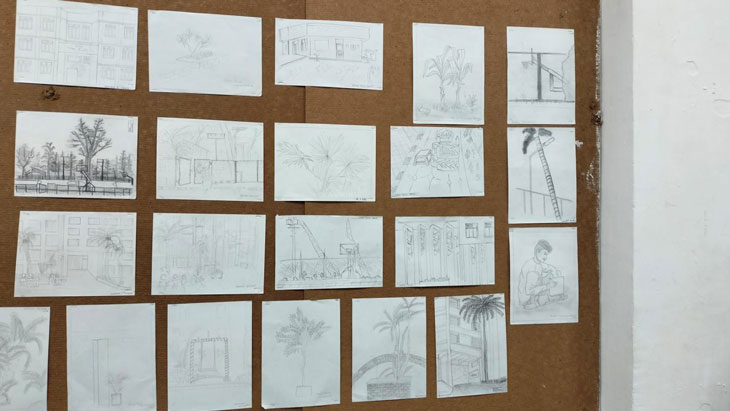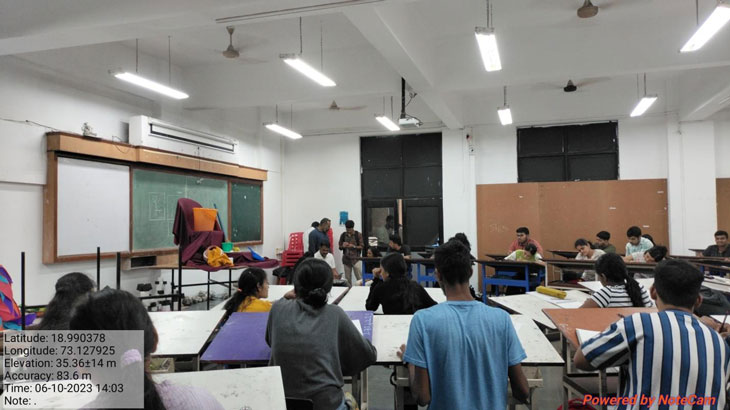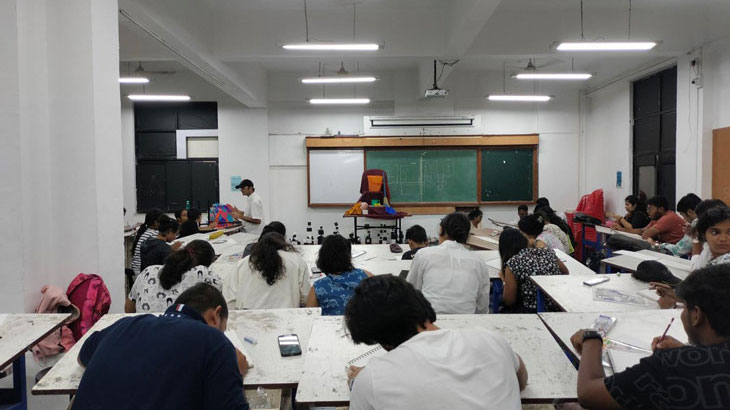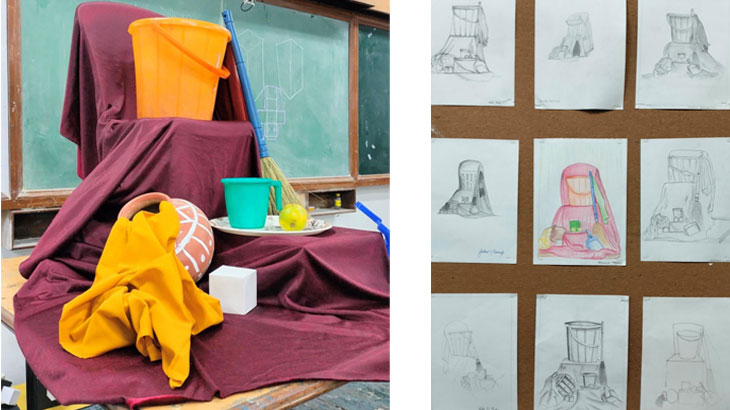| Session | 2023-24 |
| Year | First Year Batch |
| Date | 3rd to 6th October, 2023 |
| Time | 8:30 a.m. - 4:30 p.m. |
| Venue | Ground Floor Studio |
| Faculty | Co-ordinator : Prof. Ashwini Bhosale |
| Workshop Co-ordinators: Prof. Kedar Shinde, Prof. Sasmit Acharekar, Prof. Tushara Kaliyath, Prof. Aarti Mankame |
Introduction:
The Orientation Week: Foundations to Skylines was a well-crafted program designed to introduce first-year B.Arch. students to the world of architecture. This report delves into the week’s core workshops, their objectives, methodologies, and outcomes, emphasizing their role in building foundational skills and knowledge for budding architects. Held from 3rd to 6th October, 2023, at the Ground Floor Studio, this week featured workshops led by experienced faculty members covering architectural fundamentals, creative expression, and hands-on sketching and painting. The report provides a detailed examination of each workshop, highlighting their objectives, execution, and results, emphasizing the importance of this event in nurturing students’ architectural education.
A formal announcement regarding the Induction Day, Orientation Week, and Exhibition Day was circulated to notify both faculty members and students. Additionally, the Orientation Week schedule, which includes details about the assigned workshop leaders and team members, was circulated for reference.
Day 1 – 3rd October, 2023
Workshop In-charge: Prof. Kedar Shinde
Team Members: Prof. Jayesh P., Prof. Sahil, Prof. Vrinda P., Prof. Shubhangi B., Prof. Avinash S.
Workshop Title A: Surface Development
Session Brief:
The Surface Development workshop introduced students to the fundamental concept of creating visually appealing and innovative surface designs using the cube as a fundamental element. It emphasized artistic expression, skill development, and the exploration of paper as a versatile and sustainable material. The primary objectives were to introduce participants to surface development with the cube, familiarize them with working with the cube as a geometric element, teach techniques for creating surface patterns using the cube, stimulate creative thinking, and encourage the selection of appropriate media for artistic expression.
Aim:
- The primary aim of this workshop was to equip participants with the skills and knowledge needed to create visually appealing and innovative surface designs using the cube as a fundamental element.
- To improve the student’s ability to control materials, tools and techniques. To transform flat sheets of paper into intricate, visually appealing 3D structures through folding, cutting, and shaping techniques.
- The workshop aimed to inspire creativity and demonstrate how the cube can be integrated into diverse design projects.
Objectives:
- To introduce participants to the concept of surface development with the cube and its relevance in design.
- To familiarize participants with the principles of working with the cube as a geometric element.
- To teach techniques for creating surface patterns, textures, and designs using the cube as the basic building block.
- To stimulate creative thinking and problem-solving in design contexts.
- Select appropriate media relative to concepts and forms of art.
Process of Conduct:
- Choose geometric forms to create (e.g., cubes, pyramids).
- Understand the properties and dimensions of the chosen shapes.
- Develop templates for the shapes.
- Measure and cut paper according to templates.
- Fold paper along template lines to create 3D shapes.
- Assemble folded pieces into the complete geometric object.
- Secure edges and corners with glue or adhesive.
- Review and assess the quality of 3D geometric objects.
- Assignments Allocated to Students.
- Creating 3D objects from basic geometric shapes using black & white paper.
Outcomes Achieved:
Participants gained a deep understanding of cube-based surface development, the ability to apply it to real-world design challenges, enhanced creativity, problem-solving skills, improved presentation and communication skills, and developed skills and knowledge in the field of surface design using the cube as the primary geometric element.
Skills Developed Under this Workshop:
Proficiency in creating and manipulating surface patterns with the cube, application of cube-based principles, creative problem-solving, presentation, and critique skills.
Material List:
- Full-size cartridge paper – 2
- Full-size tinted black paper – 2
- Fevicol – 1
- Cutter – 1
- Long steel scale (12 inches)
- Pencil – 2B & 4B
- Eraser – Non-dust
Workshop Title B: 3D Composition
Session Brief:
The 3D Composition workshop introduced students to the world of 3D paper art, focusing on creating intricate and visually appealing 3D paper forms using various geometric shapes and origami techniques. The workshop aimed to foster spatial thinking and creativity while teaching the basics of working with paper as a creative medium. Participants were encouraged to experiment and design their own 3D paper compositions, enhancing teamwork and learning to appreciate the artistic possibilities of paper as a medium.
Aim:
The primary aim was to enable participants to craft 3D paper forms and compositions using geometric principles and origami methods. The workshop encouraged participants to develop spatial thinking and creativity through paper art.
Objectives:
- Introduction to working with paper as a creative medium.
- Familiarization with different geometric shapes and their applications in paper art.
- Teaching origami techniques and methods for creating 3D paper forms.
- Encouraging participants to experiment and design their own 3D paper compositions.
- Promoting an appreciation for the artistic possibilities of paper as a medium.
Process of Conduct:
- Introduction to Paper Art and the history of the medium.
- Introduction to key geometric shapes and their relevance.
- Teaching essential origami folds and how to create 3D forms.
- Practical exercises to create basic 3D paper forms.
- Principles of composition, balance, and arrangement.
- Designing original 3D paper compositions.
- Presentation and discussion of creations.
Assignments Allocated to Students:
- Creating basic geometric 3D paper forms.
- Designing a more complex 3D paper composition.
- Crafting an origami piece of their own design.
Outcomes Achieved:
Participants gained a fundamental understanding of paper as a creative medium, proficiency in basic origami techniques, the ability to create unique 3D paper compositions, enhanced spatial thinking and creativity, and a greater appreciation for the artistic possibilities of paper.
Skills Developed Under this Workshop:
Proficiency in origami techniques, understanding of geometric principles, creative problem-solving, spatial thinking, and presentation skills.
Material List:
- A4 size cartridge paper – 5
- Pencil – 2B, 4B, 6B, 8B, 10B
- Eraser – Non dust
- Black pen – 1
- A4 size file card – 1
Day 2 – 4th October, 2023
Workshop In-charge: Prof. Sasmit Acharekar Team Members: Prof. Rupali V, Prof. Shital M, Prof. Neha D,
Workshop Title: 3D IMPRESSIONS: Time : 8.30 A.M. To 4.00 pm
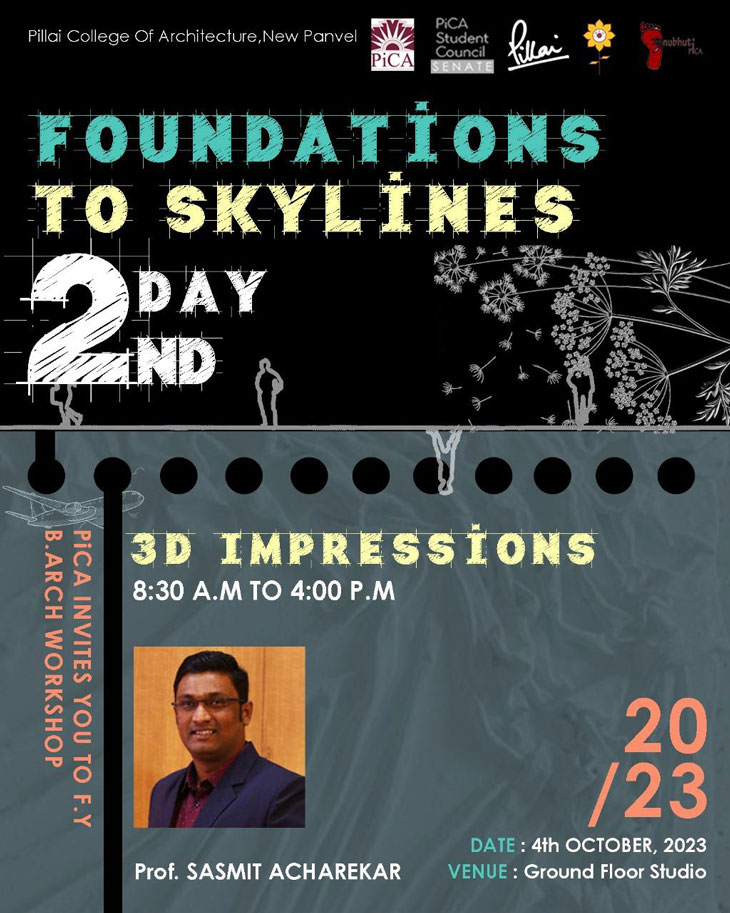
Aim:
The aim of this workshop was to understand Impression in 3 Dimensions.
Objectives:
There were 3 main Objectives that were the key focus of the workshop 1. Understanding of materials 2. Hands-on working experience 3. Learn to work in Teams
Workshop brief:
The workshop started with brief introduction of faculty members conducting the workshop. Later Prof. Sasmit initiated the discussion about what are impressions and students interpretation of the word “impressions”. Some photos were presented to the students of installations, different artists work, etc.
Students were introduced with the expected outcome which they had to work upon. They were asked to divide into 5 groups and come up with installation ideas. In the later part of the workshop, students were informed to create installation with the help of balloons and wrapping them with newspapers.
The workshop provided students an opportunity to understand impression of life size objects by creating put-on envelops over them. The warping membrane becomes the skin of the object, which was removed after drying and installed independently without the parent object. The selection of object was up to students. The only constrain was not to use table top objects.
Outcomes:
Students made Installations which could be displayed as free standing, hung to the ceiling, and with support of the walls and columns. Students learn the skill of preparing paper mesh and applying / wrapping and pasting the balloons to get proper shape and de molding it after, cutting technique for Model making, painting. This was a fun exercise, where students enjoyed as well as they learnt to work with different materials and how to handle them. Also, through this group exercise they got to know each other learnt team building and helping each other.
Day 3 – 5th October, 2023
Workshop A In-charge: Prof. Tushara Kaliyath
Team Members: Prof. Ashwini B., Prof. Jayesh P.
Workshop Title:
Architectural Vogue: Reinventing Design With Newspaper Couture
Time: 8.30 A.M. To 12.30 pm
Workshop B In-charge: Prof. Aarti Mankame
Workshop Title: Architectural Legends Unveiled: A Book Exhibition
Time: 12.30 P.M. To 4.30 pm
Workshop A: Architectural Vogue: Reinventing Design with Newspaper Couture
Session Brief:
The “Architectural Vogue: Reinventing Design with Newspaper Couture” Workshop is a transformative experience that seamlessly fused architecture, sustainability, and avant-garde fashion. Participants embarked on a creative odyssey, using newspapers as an unconventional medium to craft architectural-inspired dresses. Sustainability took center stage as discarded newspapers were repurposed into stunning couture, highlighting the workshop’s commitment to responsible design choices. Through collaborative teamwork, participants brought architectural visions to life in the form of wearable art. The architectural principles of form, function, and aesthetics were brilliantly applied to fashion, showcasing the limitless possibilities of creativity and innovation. The grand architectural runway show was a culmination of their efforts, leaving a lasting impression on both participants and spectators. This workshop was not just a celebration of creativity; it was a profound exploration of the architectural spirit within fashion, leaving participants with a newfound appreciation for the boundless world of design possibilities.
Aim:
The aim of this workshop is to introduce architectural students to unconventional design materials, foster creativity, encourage sustainable design, and enhance team collaboration through Basic Design Elements by repurposing newspapers into architectural couture.
Objectives:
- Spatial Ingenuity: To acquaint students with the principles of spatial composition, balance, and form, drawing parallels between architectural structures and dress design.
- Material Exploration: To teach students the art of manipulating materials, emphasizing the transformative potential of newspapers, just as architects mold raw materials into visionary structures.
- Design Innovation: To inspire students to break free from traditional design boundaries, encouraging them to innovate and experiment, mirroring the innovation that drives architectural evolution.
- Collaborative Synergy: To cultivate teamwork and mutual understanding within architectural groups, enhancing their capacity to create harmonious and functional spaces.
Process of conduct:
- Introduction:
- Welcome and overview of the day’s objectives by Prof. Tushara Kaliyath.
- Emphasis on the significance of sustainability in architectural and Basic Design.
- Newspaper as a Material:
- Introduction to using newspapers as a design medium.
- Discussion on the properties of newspapers, their availability, and sustainability aspects.
- Presentation:
- Presentation on creating architectural-inspired dresses using newspapers by Prof. Tushara Kaliyath.
- Focus on concepts such as structural integrity, spatial dynamics, and aesthetics.
- Group Formation:
- Organizing students into groups of 9 or 10 to encourage collaborative teamwork.
- Designing Architectural Dresses:
- In groups, students sketched and design architectural dresses using newspapers.
- Dress Construction:
- Groups assembled their architectural dresses, focusing on structural integrity and design cohesion.
- Encouragement of teamwork and creative problem-solving.
- Fashion Show Preparation:
- Groups prepare models (students) and rehearsed for the grand fashion show.
- Fashion Show:
- A culminating event where each group presented and showcases their architectural dresses in front of all the faculties and Principal Dr. Sudnya Mahimkar.
- Critique and Discussion:
- Students present their creations, discussing the design process, challenges faced, and solutions found.
- Reflection and Closing:
- A brief discussion on the lessons learned, emphasizing the importance of sustainable design in architecture, and reflecting on the bonding experience throughout the day.
Assignments allocated to the students:
- Sketch a rough idea of a simple architectural element or structure you would like to incorporate into your newspaper fashion piece, based on the concepts learned during the demonstration.
- Collaborate within your design team to outline the initial concept for your architectural dress, including rough sketches and a brief description of the architectural inspiration behind it.
- As your group constructs the architectural dress, designate roles within the team (e.g., one member focusing on structure, another on aesthetics). Take photos documenting the construction process for a brief presentation.
- Prepare your models and rehearse the presentation of your architectural dresses for the fashion show. Decide on the order of presentation and ensure your team is ready for the runway.
- Present your architectural dresses in the fashion show. Each team will showcase their creation on the runway. (Part 2): After the fashion show, engage in a reflection session with your team to discuss the experience, challenges faced during the show, and the audience’s reactions.
Outcomes achieved:
- Embody Architectural Thinking: Showcase proficiency in transforming spatial and structural concepts into wearable art.
- Material Mastery: Apply architectural and Basic Design concepts to manipulate unconventional materials effectively.
- Innovative Vision: Demonstrate the courage to innovate and redefine Basic Design boundaries.
- Unified Design Teams: Strengthen teamwork skills while creating cohesive and imaginative Basic Design Elements in architectural fashion
Skills Developed Under This Workshop:
- Creativity: Students will learn to think innovatively and apply architectural and Basic Design concepts to fashion design.
- Design Thinking: They will develop problem-solving skills through the design process.
- Sustainability: Understanding the importance of sustainable design practices.
- Teamwork: Collaboration and communication within groups.
- Presentation: Students will enhance their communication skills through the fashion show.
List of materials that students will need:
- Newspapers: The primary material for creating the architectural fashion pieces. Make sure you have an ample supply, as students may need to experiment and make adjustments.
- Scissors: Essential for cutting and shaping the newspaper.
- Adhesives: Provide options like glue, tape, or even eco-friendly alternatives like starch paste or homemade paper glue for adhering newspaper layers together.
- Cardboard or Poster Board: For creating structural supports or bases for the fashion pieces.
- Markers and Coloured Pencils: For sketching and adding detail to the designs.
- Rulers and Measuring Tape: To ensure precision in design and construction.
- Fabric or Fabric-Like Materials: Depending on the complexity of the designs, students may need some fabric or cloth for embellishments or to add variety to the materials used.
- Designing Tools: Pins, needles, and thread if sewing or attaching fabric components is part of the design.
- Fashion Accessories: Depending on the design concepts, students may want to incorporate accessories like buttons, zippers, or ribbons.
- Design Sketchbooks or Paper: For students to sketch out their design ideas before starting the actual construction.
- Cleaning Supplies: Newspapers can be messy, so having cleaning supplies like paper towels or wipes on hand is a good idea.
- Aprons or Old T-Shirts: To protect clothing from potential newspaper ink smudges.
Workshop B: Architectural Legends Unveiled: A Book Exhibition
Session Brief:
The workshop was designed for the fresher’s to get to know the legends of our architectural field & to get introduced to PiCa’s extensive library. The workshop started with an introductory presentation to guide the students for the workshop, explain them about the unique signature of any designer or an artist and how to identify it.
The library in charge Ms. Biji maam oriented students through the library’s working, after that students were given time to go through the book exhibition specially curetted for them and select one legend of their liking.
Then the student has to go through his/her work and asked to make an illustration using pencil & colours which depicts that perticular legend’s style.
Students created interesting illustrations which resonates with the legends work. This outcome was a tribute to these legends in architecture which was then displayed in the induction day exhibition.
Day 4 – 6th October 2023
Workshop In-charge: Prof. Prof. Kedar Shinde
Team Members: Prof. Jayesh P., Prof. Sahil, Prof. Shubhangi B., Prof. Avinash , Prof. Vrinda
Workshop Title:
A. Freehand sketching: Time : 8.30 A.M. To 12.30pm
B. Introduction to Still Life Art: Time : 12.30 P.M. To 4.30 p.m.
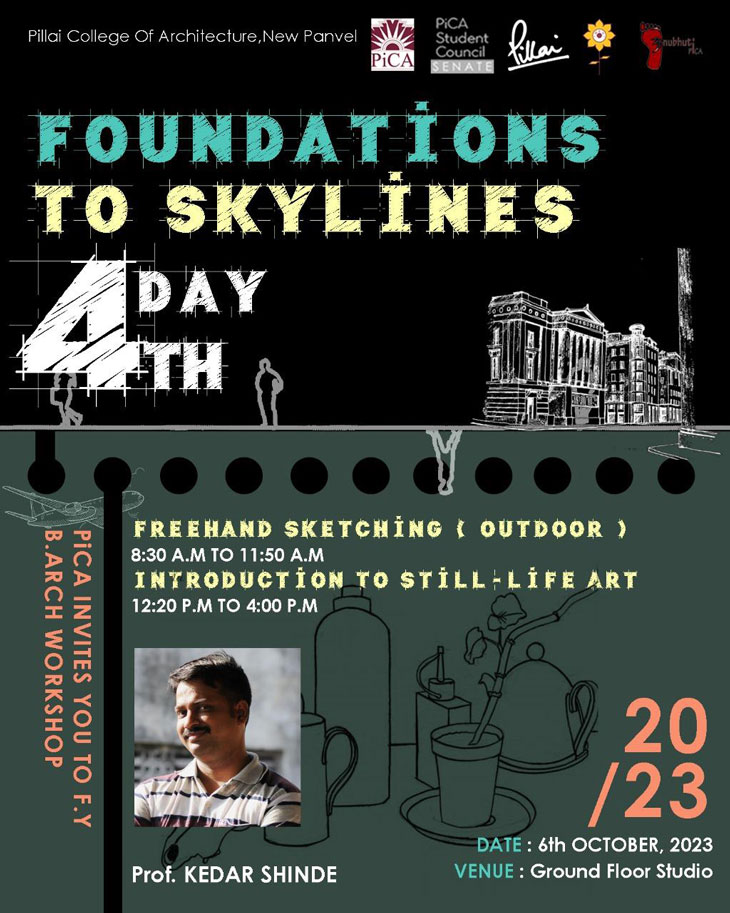
Workshop A: Freehand sketching
Session Brief:
The Freehand Sketching Workshop was a creative and practical event aimed at introducing participants to the art of freehand sketching. The workshop provided an opportunity for participants to explore the world of drawing and sketching by hand, without relying on digital tools or aids.
Aim:
The primary aim of this workshop was to foster participants’ freehand sketching skills and to encourage them to express their creativity and observations through the medium of sketching. The workshop aimed to instill a love for drawing and to emphasize the importance of sketching as a valuable tool for communication and personal expression.
Objectives:
- To introduce participants to the art of freehand sketching and its significance in various fields.
- To familiarize participants with fundamental drawing techniques and tools.
- To encourage participants to observe and capture objects, scenes, and ideas through sketching.
- To inspire creative thinking and self-expression through sketching.
- To promote the development of artistic skills and visual communication.
Process of conduct:
- Introduction to Freehand Sketching: An overview of the importance of freehand sketching in art, design, and communication.
- Basic Drawing Techniques: Instructors taught participants fundamental drawing techniques such as line, shape, perspective, shading, and proportion.
- Sketching Exercises: Participants engaged in a series of sketching exercises, starting from simple objects and gradually moving to more complex scenes and concepts.
- Observational Sketching: A significant portion of the workshop was dedicated to observational sketching, where participants sketched objects and scenes from life.
- Creative Exploration: Participants were encouraged to experiment with different styles and approaches to sketching.
- Group Sharing and Feedback: Participants shared their sketches, received feedback from both peers and instructors, and engaged in discussions about their work.
Assignments allocated to the students:
Sketching simple geometric shapes and everyday objects.
Capturing a scene or landscape through freehand sketching, paying attention to perspective and composition.
A creative project where participants had the freedom to express their ideas and imagination through freehand sketching.
Outcomes achieved:
- Participants developed a strong foundation in freehand sketching techniques.
- Proficiency in capturing objects, scenes, and ideas through sketching.
- Enhanced observation skills and attention to detail.
- Improved creative thinking and self-expression through sketching.
- A portfolio of sketches reflecting various styles and subjects.
Skills developed under this workshop:
- Proficiency in basic freehand sketching techniques.
- Observation and attention to detail.
- Creative thinking and self-expression through sketching.
- Improved visual communication skills.
- Confidence in using freehand sketching as a tool for artistic expression.
Material List:
- A4 size cartridge paper – 10 sheet
- Pencil – 2B, 4B, 6B, 10B
- Eraser – Non dust
- Color pencil – 1
- A4 size exam pad
Workshop B: Introduction to Still Life Art
Workshop Brief:
The Introduction to Still Life Art Workshop was a creative and immersive event designed to introduce participants to the art of still life composition and painting. The workshop provided an opportunity for participants to explore the world of still life art, a genre that involves arranging and capturing inanimate objects in a visually compelling manner.
Aim:
The primary aim of this workshop was to acquaint participants with the art of still life, enabling them to appreciate its significance in the world of art and to develop their own skills in creating still life compositions. The workshop aimed to inspire creativity and highlight the role of still life art in both traditional and contemporary art contexts.
Objectives:
- To introduce participants to the history and importance of still life art.
- To familiarize participants with the fundamentals of composition, lighting, and color in still life.
- To teach painting techniques, including brushwork, shading, and color mixing.
- To encourage participants to create their own still life compositions.
- To inspire creative thinking and artistic self-expression through still life art.
Process of conduct:
The workshop was conducted as follows:
- Introduction to Still Life Art: An overview of the history and relevance of still life art in the world of visual arts.
- Composition and Lighting: Instructors explained the principles of composing still life setups and the role of lighting in creating a dramatic effect.
- Painting Techniques: Participants were introduced to various painting techniques, including brushwork, shading, and color mixing.
- Still Life Setup: Participants arranged their own still life subjects, selecting objects that appealed to them and set them up for painting.
- Hands-on Painting: Participants engaged in practical painting exercises, capturing the still life composition they had set up.
- Creative Exploration: Participants were encouraged to experiment with different styles and approaches to still life art.
- Group Sharing and Feedback: Participants shared their works, received constructive feedback from both peers and instructors, and engaged in discussions about their creations.
Assignments allocated to the students:
- Throughout the workshop, participants were given assignments to apply their understanding and skills:
- Creating a simple still life composition and painting it in a realistic style.
- Designing a more complex still life setup and capturing it in a style that reflects their personal artistic expression.
- A creative project where participants had the freedom to explore unconventional still life themes.
Outcomes achieved:
The workshop led to several notable outcomes:
- Participants gained a fundamental understanding of the history and significance of still life art.
- Proficiency in the basics of still life composition, including arranging objects and controlling lighting.
- Improved painting techniques, including brushwork, shading, and color mixing.
- Enhanced creative thinking and self-expression through still life art.
- A portfolio of still life artworks reflecting various styles and subjects.
Skills developed under this workshop:
- Participants developed a range of skills during this workshop, including:
- Proficiency in still life composition and arrangement.
- Creative thinking and self-expression through still life art.
- Improved observation and attention to detail.
- Confidence in using still life as a subject for artistic expression.
Material List:
- Full size cartridge paper – 1
- Pencil – 2B, 4B, 6B, 8B, 10B
- Eraser – Non Dust
- Colour pencil – 1
- Any color medium (ex. Water color, poster color etc)
Thus, the Foundations to Skylines workshops provided numerous benefits, including fostering creativity, improving problem-solving skills, enhancing spatial thinking, encouraging teamwork, promoting sustainable design, and developing proficiency in various artistic techniques. Students gained a deeper understanding of their chosen field and acquired practical skills that will be invaluable in their architectural studies and careers.


